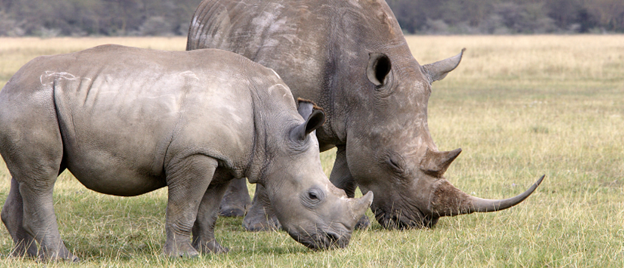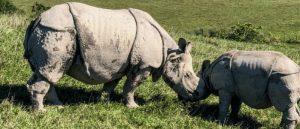
BioTechniques News
Beatrice Bowlby

There is hope for critically endangered northern white rhinoceros as scientists produce primordial germ cells from stem cells.
A mother and daughter make up the last surviving members of the northern white rhinoceros (NWR) population. In a bid to bring them back from the brink of extinction, the BioRescue team (Berlin, Germany) are trying to create lab-grown egg and sperm cells. In a recent publication, the team have announced a breakthrough; they were able to turn stem cells into primordial germ cells (PGCS). This is an initial step towards producing NWR gametes in culture and saving this critically endangered subspecies.
As a results of decades of poaching, NWR are functionally extinct in the wild, which means that the population is no longer viable without human intervention. As a result, an international team of scientists have set out to generate gamete precursors from induced pluripotent stem cells to produce embryos, which could then be implanted into closely related surrogates – southern white rhinos.
Skin cells: the key to saving an endangered species?
The co-senior authors on the study, Katsuhiko Hayashi (Osaka University and Kyushu University, both Japan), Thomas Hildebrandt (Leibniz Institute for Zoo and Wildlife Research, Berlin, Germany) and Sebastian Diecke (Max Delbrück Center, Berlin, Germany), set out to achieve what had previously only worked in rodents and primates – generating PGCs from skin cells. The skin cells they used were collected from Fatu’s (surviving NWR daughter) aunt, Nabire, who died in 2015 at Safari Park Dvůr Králové in the Czech Republic. The first author on the study, Masafumi Hayashi (Osaka University), explained, “this is the first time that primordial germ cells of a large, endangered mammalian species have been successfully generated from stem cells.”
Researchers were also able to identify a gene, SOX17, which is important for PGC induction in rhinoceros. As this gene is also key for the development of human germ cells, the same may be true for other mammalian species, which could further our understanding of stem cells and reproductive biology.
Hayashi and colleagues were also able to grow southern white rhinoceros PGCs and identified two markers, CD9 and ITGA6, which were expressed on the surface of both white rhino subspecies. Hayashi elaborated, “going forward, these markers will help us detect and isolate PGCs that have already emerged in a group of pluripotent stem cells.” The team are hoping that these new discoveries could be used to save all five rhino species, almost all of which are classified as critically endangered by the International Union for Conservation of Nature’s Red List.
The next step will be to mature the PGCs so that they become gametes. Vera Zywitza (Max Delbrück Center), another author of the study, explained, “the primordial cells are relatively small compared to matured germ cells and, most importantly, still have a double set of chromosomes. We therefore have to find suitable conditions under which the cells will grow and divide their chromosome set in half.”
 Genomic sequencing: saving the unicorns
Genomic sequencing: saving the unicorns
Researchers have sequenced the genomes of different endangered and extinct rhinoceros to establish the genetic variability of the remaining populations in an effort to conserve them.
Creating viable populations through genetic variation
Hildebrandt’s plan was to fertilize egg cells collected from Fatu through intracytoplasmic sperm injections (ICSI) using sperm collected from four now deceased northern white rhino bulls. However, neither of the surviving NWR are able to bear children of their own. Due to issues with her Achille’s tendon, Fatu is unable to carry additional weight and her mother, 33-year-old Najin, is past childbearing age. In any case, the genetic variation arising from a single egg donor would be too small to create a viable population. Therefore, the team’s focus is now to turn the PGCs into egg cells.
As ovarian tissue is a crucial step in forming egg cells in mice, the same is likely true for rhinos. However, this tissue cannot be collected from the remaining NWR, so it may also have to be grown from stem cells. Alternatively, scientists may be able to use horse ovarian tissue as they are the closest living relatives to rhinoceros.
A second chance for rhinos
Jan Stejskal, Director of Communication and International Projects at Safari Park Dvůr Králové, hopes that this could be the opportunity that rhino populations need to recover, “we are thrilled that the BioRescue scientists have achieved this milestone and that Nabire, who died in 2015 in Dvůr Králové, is still able to help save her species. Unfortunately, she didn’t have any offspring during her life, but recent successes in stem-cell associated techniques have shown that it is perfectly possible that a direct descendant of Nabire will be born at some point in the future and can play an important role in repopulating central Africa with northern white rhinos.”
The post Northern white rhinoceros could be brought back from the brink of extinction appeared first on BioTechniques.
Full BioTechniques Article here
Powered by WPeMatico
